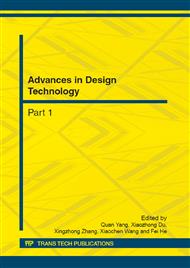[1]
Ashdown, S. P. Lucy Dunne, in: A Study of Automated Fit: Readiness of the Technology for the Apparel Industry, Submitted to 2006 International Textile & Apparel Association, Volume 24, page121.
DOI: 10.1177/0887302x0602400206
Google Scholar
[2]
DesMarteau, K. (2000, October). CAD: Let the fit revolution begin. Bobbin, 42-56.
Google Scholar
[3]
G.Song, in: Thermal Insulation Properties of Textiles and Clothing, Woodhead Publishing Ltd; Proof copy not for publication. page:19.
Google Scholar
[4]
Ralph F. Goldman, Biomedical Effects of Military Clothing and Equipment Systems, in: Handbook on Clothing, 2nd Edition Bernhard Kampmann 2007, Chapter 2-3(1)
Google Scholar
[5]
S. X. Wang, Y. Li1, in: Effect of Moisture Management on Functional Performance of Cold Protective Clothing, submitted to Textile Research Journal Vol. 77(12).
Google Scholar
[6]
Ralph F. Goldman, Biomedical Effects of Military Clothing and Equipment Systems, in: Handbook on Clothing, 2nd Edition Bernhard Kampmann 2007, Chapter 2-3(1)
Google Scholar
[7]
Janice Huck,Oprah Maganga andYounghee Kim, in: Protective Overalla: Evaluation of Garment Design and Fit, submitted to International Journal of Clothing Science and Technology, Received May 1996, Vol. 9. No. 1, page 45-61.
DOI: 10.1108/09556229710157876
Google Scholar
[8]
Yejin Leea, Kyunghi Honga, in:3D Quantification of Microclimate Volume in Layered Clothing for the Prediction of clothingInsulation, Received 28 March 2005; accepted 4 April 2006, by Applied Ergonomics 38 (2007) 349–355.
DOI: 10.1016/j.apergo.2006.04.017
Google Scholar
[9]
Xin Lisha, Li Jun, in: Study of Protective Clothing Functional Design Model, submitted to Journal of Textile Research, Vol.32, No.11, Vol. 2011.(in Chinese)
Google Scholar
[10]
Goldman Ralph F, in: the Four ' Fs' of Clothing Comfort [J], Environmental Ergonomics, 2005(3), 315-320.
Google Scholar
[11]
Il Young Kim, Calvin Lee, in: Investigation o f Air Gaps Entrapped in Protective Clothing Systems [ J]. Fire and Materials, 2002, 26: 121-126.
DOI: 10.1002/fam.790
Google Scholar
[12]
Zhang Xiang-hui, Li Jun, in: Effects of Clothing Construction Design on Protective Clothing Comfort, submitted to Journal of Xi an Polytechnic University 2009.04 , Vol.23, No.2, page:61.
Google Scholar
[13]
Ruckman Je, Murray R, in: Engineering of clothing systems for improved thermo physiological comfort: the effect of openings [ J]. International Journal o f Clothing Science and Techno logy, 1999, 1( 1): 37-52.
DOI: 10.1108/09556229910258098
Google Scholar
[14]
Susan Ashdown, Leater; in: Use of Body Scan Data to Design sizing Systems Based on Target Market, submitted to National Textile Center Research Brief-Manadement Systems Competency:june 2003.
Google Scholar
[15]
Laura K. Kidd, in: A Case Study: Creating Special Occasion Garments for Young Women Wish Special Needs, submitted to 2006 International Textile & Apparel Association, vol. 24, page 161.
DOI: 10.1177/0887302x0602400209
Google Scholar
[16]
B. Le Pechoux and T.K. Ghosh, in: Apparel Sizing and Fit, Textile Progress Vol. 32. No. 1, page 321.
Google Scholar


